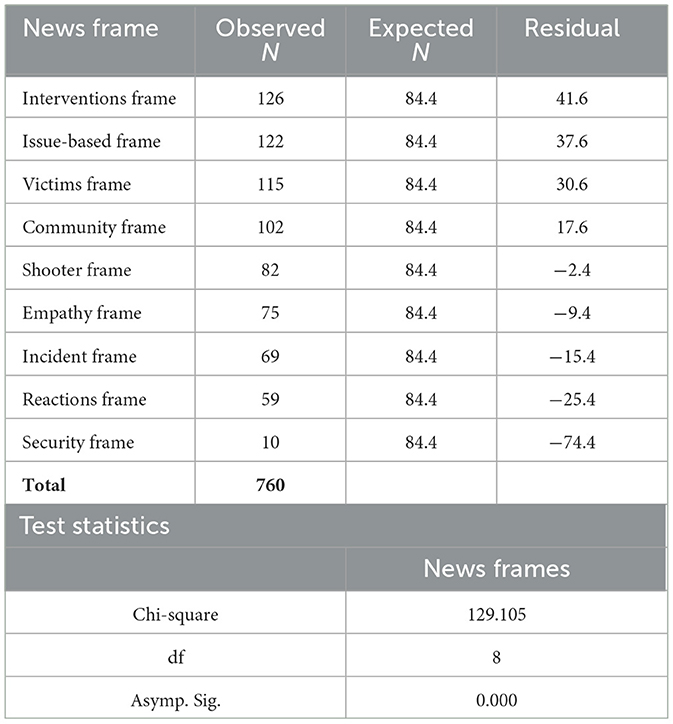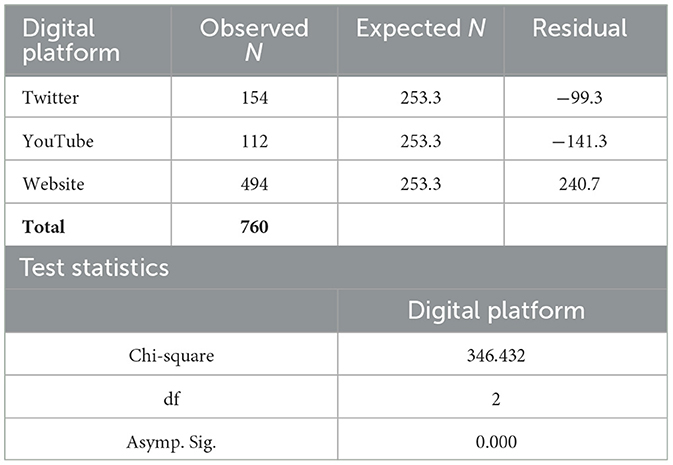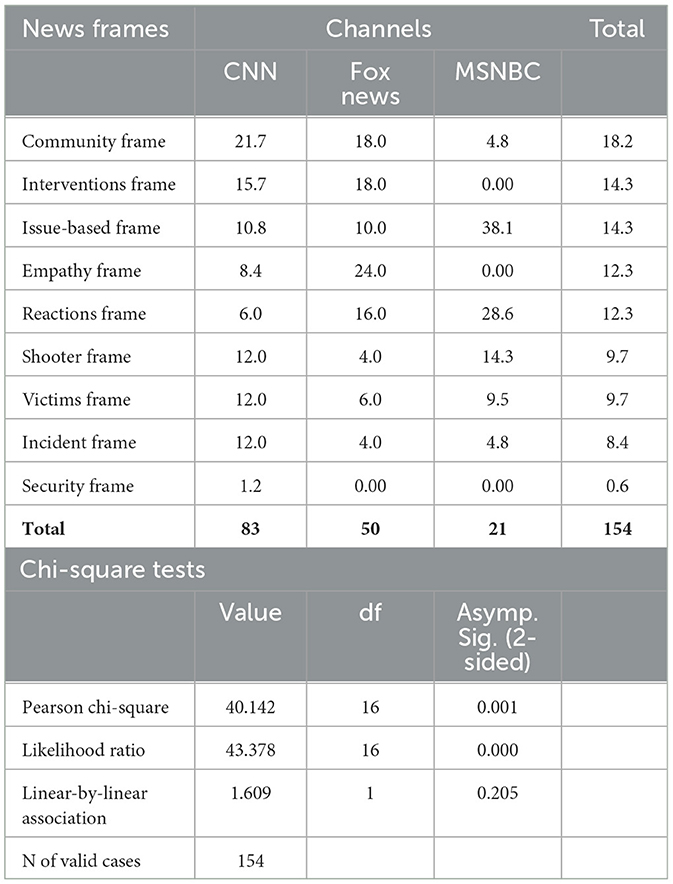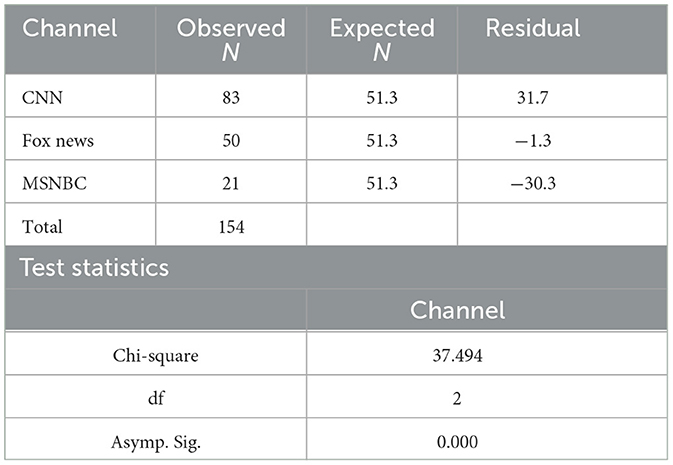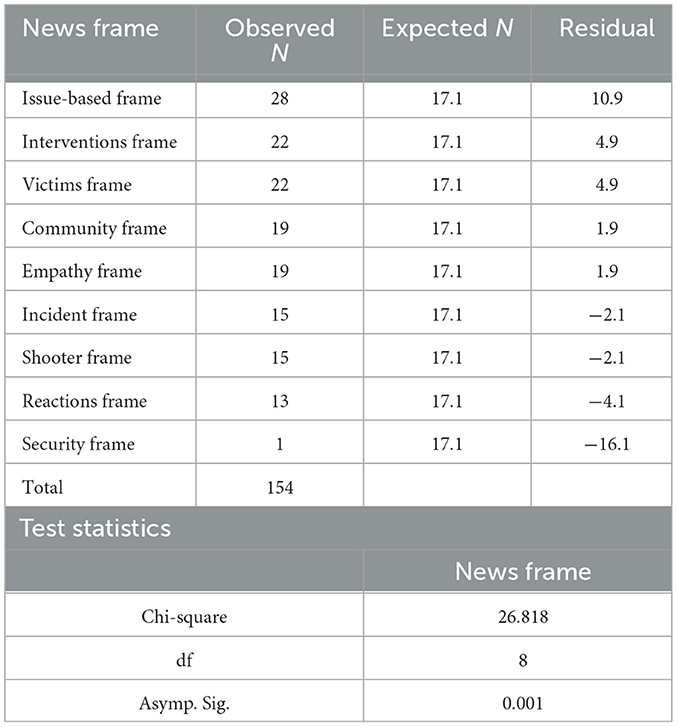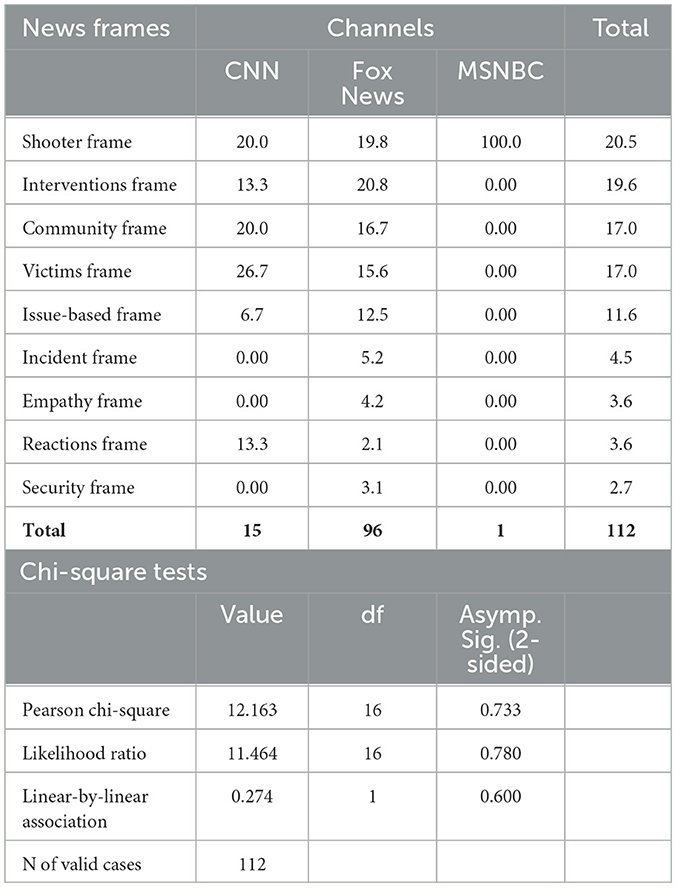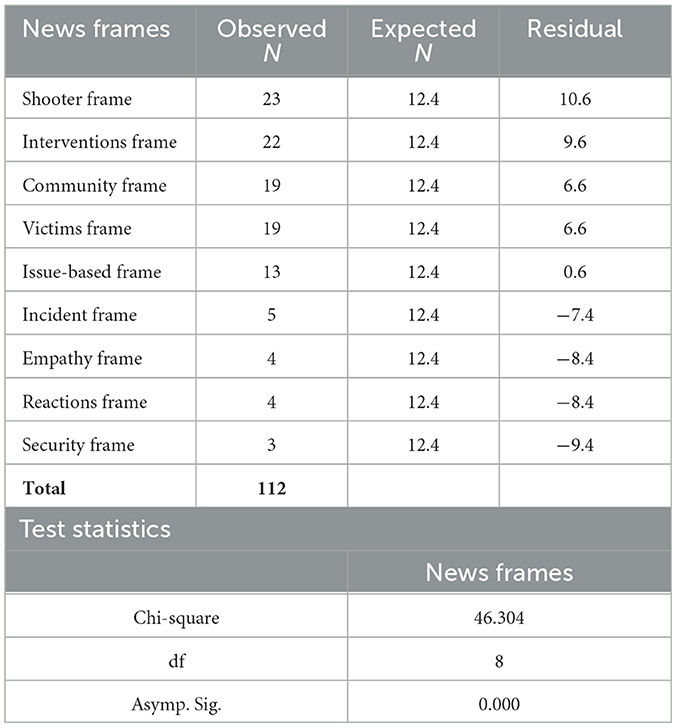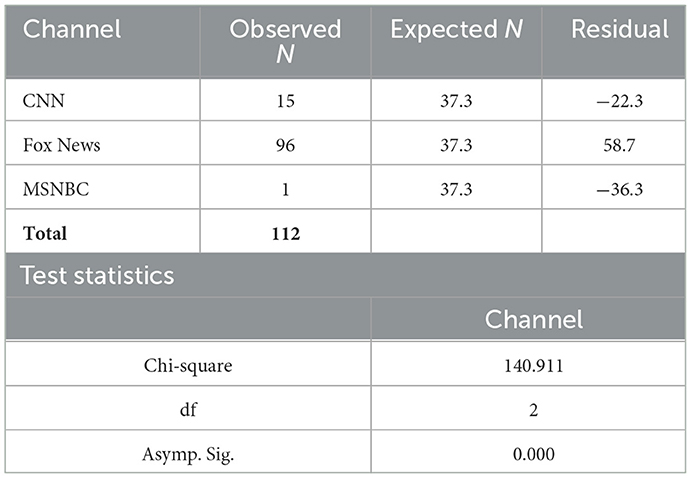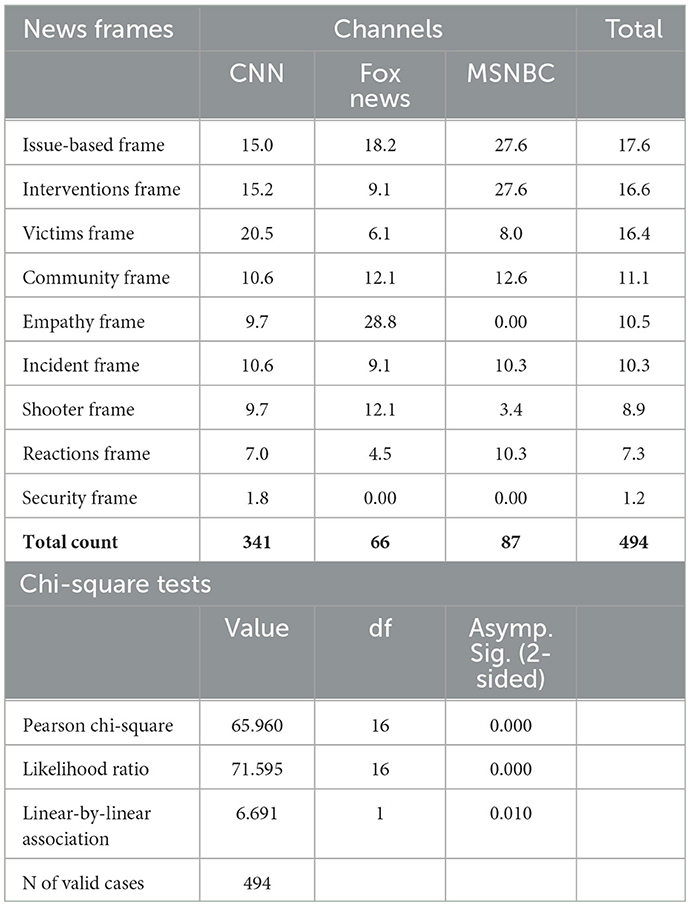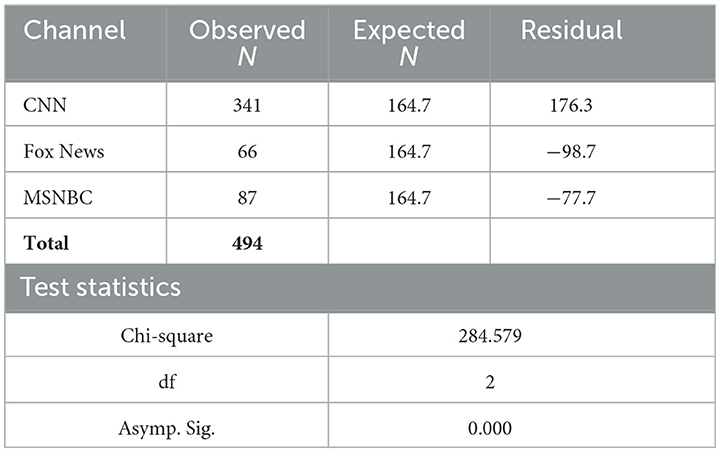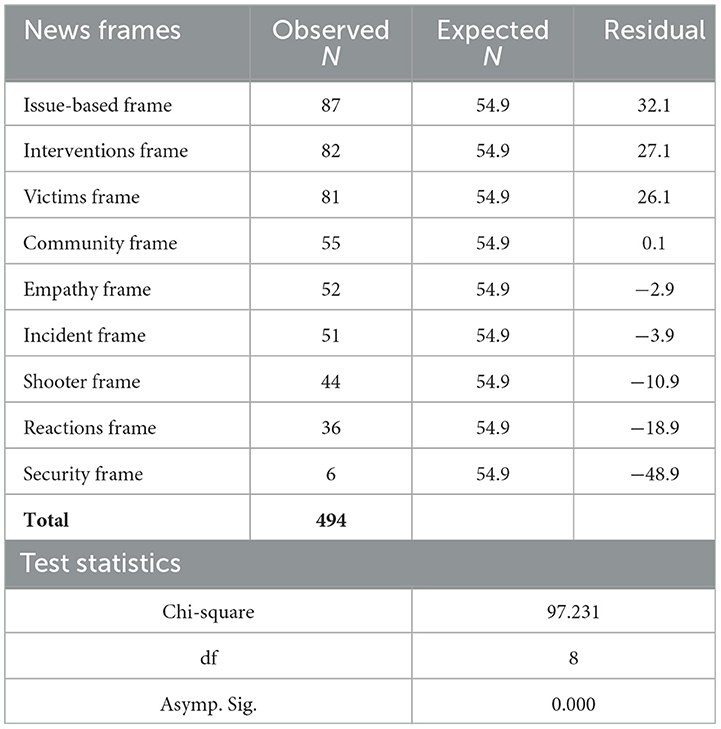- Tim Russert Department of Communication, John Carroll University, University Heights, OH, United States
News frames play a vital role in shaping the audience's interpretation of the news, their participation in policy discussions, and their engagement in public discourse. This study uses the Analysis of Topic Model Networks (ANTMA) frame analysis grounded approach and examines the 2017 Sutherland Springs, Texas, mass shooting coverage in a house of worship by three U.S. cable television networks—CNN, Fox News, and MSNBC. News reports for the first seven days following the shooting were collected from the cable networks' Twitter, YouTube, and website accounts. A total of 290 news reports were analyzed and 760 aggregate units for frames were coded. The results demonstrate that ANTMA grounded approach is an effective method for frame analysis and support research about the news media's emphasis on victims, community, and individual frames in cases of mass shootings. They identify differences in the issue-based frame of gun vs. mental health debates. Additional new frames of empathy, interventions, reactions, and security were discovered. Results also show differences in frames used and their frequency between the digital platforms of Twitter, YouTube, and websites and cable organizations. These differences show each media network's ideological perspectives or competing news narratives. The findings raise relevant questions to news coverage, policy debates about mental health and gun violence, and cultural awareness of the problem of mass shootings and public safety as the world becomes more global.
Introduction
News coverage provides perspectives on how policymakers might respond to incidents such as mass shootings, and studies show that news frames shape conversations on policy and public debates (Luca et al., 2016; Silva and Capellan, 2019). Frame analysis is relevant to understanding mass shooting news coverage. In response to the seminal study of mass shooting data by Lankford (2015, 2016a), researchers have employed episodic and thematic frame analysis methods to gain a better understanding of how these tragedies are portrayed in news coverage. Such studies focus primarily on frames related to guns, mental health, or both (Kleck, 2009; McGinty et al., 2013; Lott and Moody, 2019). However, what remains unexamined is whether this emphasis overlooks potentially vital alternative perspectives which may play an influential role when it comes to news coverage and the shaping of public perception around such events.
This study aims to utilize a grounded approach, the Analysis of Topic Model Networks (ANTMN) method (Walter and Ophir, 2019), to identify emergent news frames and their frequency of use in the CNN, Fox News, and MSNBC's coverage of mass shootings on their official Twitter, YouTube, and website accounts. Thus, it answers the following question: What frames are present in the CNN, Fox News, and MSNBC networks' coverage of the Sutherland Springs mass shooting and are there differences in the news networks' framing of the story across their official Twitter, YouTube, and website accounts? Additionally, it critically analyzes the implications of any disparities in their coverage in the context of ongoing debates surrounding mass shootings in the United States. By comparing these findings to previous research and presenting interdisciplinary relevance, this inquiry seeks to offer clear, descriptive language and analysis of the framing strategies employed by U.S. cable news networks in the specific case of a mass shooting in a house of worship.
Therefore, this study uses the ANTMN grounded inductive method to analyze news frames of the 5 November 2017 Sutherland Springs mass shooting to identify if other frames are present. ANTMN is a new frame analysis device, a grounded approach that provides a topic-by-topic and content-by-content coding of the text to identify coherent themes, using computerized tools to find emergent patterns. Thus, this study will demonstrate how identified frames reveal the competing narratives (if not competing ideologies) implicit in each network's coverage. In addition, it critically examines what this might mean to frame analysis scholarship, news coverage, and policymaking in relation to mass shootings, mental health, gun violence, and public safety.
Previous scholarship
Frame analysis
Goffman (1974) introduced scholarship in frame analysis conceptualization, and Tuchman (1978) and Gitlin (1980) pioneered frame analysis research. Frame analysis is an approach in communication and sociological research that has attracted significant interest and debates since its birth (Kahneman and Tversky, 1984; Entman, 1993; Entman et al., 2009; Cacciatore et al., 2016). It is a critical analysis of the process in which media give visibility to specific issues, experiences, and events to make them seem more important than others. It is like giving people “the birds' eye view” on how they should ponder the event by only presenting selected accounts from the perspectives of these matters (Cacciatore et al., 2016; Walter and Ophir, 2019); thereby shaping audiences' understanding of the event. Entman (1993) emphasizes that framing involves “selection and salience”; that is, it entails the selection of particular aspects of perceived reality and emphasizing them (salience) within a communicative text, to promote a specific “problem definition, causal interpretation, moral evaluation, and/or proposed solution for the subject” under discussion (p. 52). Unlike agenda-setting theory, which Cohen (1963) states might not tell people how to think, but provides them “what to think about”, frames tell audiences “how to think” (Walter and Ophir, 2019, p. 249) about issues and events through the ways the media present or omit the schemas that represent the stories. While media or news frames might be arbitrary, when recurrent, they constitute a part of the news mold for the media organization that uses them. In other words, frame analysis identifies and examines frames for problem definition, analysis of possible causal relationships, moral evaluations, and solutions to the framed reality. Thus, problem definition, causal interpretation, moral evaluation, or proffering of the solution have become a common process through which frame analysis is conducted.
Framing theory uses several approaches. At the macro-level of the debate, Borah (2011) and Baran et al. (2020) classify the theoretical framework into postpositivist and critical cultural research. Postpositivist researchers focus more on identifying and measuring specific effects frames might have on audiences. Critical cultural researchers are concerned with the role of power and control over media frames and how they shape individuals and social structures and movements (Baran et al., 2020). They identify such power in the domains of news media, economics, social and political institutions, and others. Both theoretical traditions have a shared understanding that how news stories are framed relates to the audiences' responses to the story.
Researchers also study various conceptual and methodological approaches to frame analysis. The methodological approaches seem to be the most debated frame research issue, for which D'Angelo's groundbreaking edited collections (D'Angelo, 2018) provide empirical and theoretical models. D'Angelo (2017) identifies two overarching methodologies evident in determining the process of contextualization, “the purposeful “establishment of a frame of reference for a topic.” They are “equivalency framing” (Entman, 1993) and “emphasis framing” (D'Angelo, 2017). Equivalency framing is about creating different yet “logically equivalent information to produce framing effects” (Cacciatore et al., 2016; Walter and Ophir, 2019, p. 249). Emphasis framing is “based on the premise that the selective presentation of events and issues through a focus on different arguments, perspectives, and facts could influence audiences' thinking and reactions” (Walter and Ophir, 2019, p. 249; Gitlin, 1980). In such frames, there is the repeated association of certain pieces of information or omission of other possible relevant topics to “define the topic and purvey a set of judgments about it” (D'Angelo, 2017, p. 1; Entman, 1993).
Researchers' attention to specific aspects of emphasis frames shows in a further subdivision of this approach, the use of episodic or context frames. D'Angelo (2017) classifies episodic frames as a generic kind such as in Iyengar's (1996) study of episodic vs. thematic news frames or Semetko and Valkenburg (2000) use of frames of conflict, human interest, economic consequences, and morality. These frames are different from the context-specific frames (thematic frames) that De Vreese (2005, 2010) advances or the frames around social protest (Nelson et al., 1997). Both context-specific and generic frames provide a rich context that requires further specificity for measurement.
Walter and Ophir's (2019) Analysis of Topic Model Networks (ANTMN) is a new frame analysis device, a grounded approach that provides a topic-by-topic and content-by-content coding of the text to identify coherent themes, using computerized tools to find the emergent patterns. It is an inductive mixed-method computational approach. Instead of seeking to find the thematic frames and the episodic frames in the news stories thereby forcing the researcher to see the data from preconceived notions, the ANTMN seeks to discover what frames are emergent in the text of the stories as they are critically examined.
The approach identifies frames through three coding and analysis processes: topic modeling, network structure, and coherent frames. Some of its assumptions are like Dan's (2015, 2018) integrative framing analysis of verbal-visual frames on television. Dan discourages the “gestalt coding approach” (Graber, 1986, 1987) and suggests three possible units of analysis that break up the stories into a three-part continuum and codes them accordingly for congruence (Dan, 2018, p. 203) and rigor (Neuman, 2018). ANTMN follows the same framework but applies a tool-oriented computerization scheme to the method. The strength of this mixed-method inductive approach is that it incorporates equivalency framing and emphasis framing while allowing for the researchers' grounded discovery in the media frames that are latent, if not embedded, in each media publication. In this way, it addresses Dan's (2015) concerns that a gestalt approach might ignore salient aspects in the news frames. Walter and Ophir (2019) found that the ANTMN method provides more frames; and that, currently, no study has examined mass shootings in a house of worship using ANTMN.
Mass shooting and frame analysis
The term mass shooting was introduced into the United States' public discussion following the Texas sniper shooting of 1966 (Kelly, 2012; Lankford, 2015). Since then, scholars have debated the formal definition or classification of the phenomenon. However, current research—Lankford (2016a,b), Lott and Moody (2019), Peterson and Densley (2022), and Lankford and Tomek (2018)—follow what has become a synthesis in the United States, a definition advanced by the United States Congress. Mass shootings refer to shootings with four or more casualties, excluding the shooter/shooters, “not including the offender(s)—within one event, and at least some of the murders occurred in a public location or locations in close geographical proximity (e.g., a workplace, school, restaurant, or other public settings), and the murders are not attributable to any other underlying criminal activity or commonplace circumstance (armed robbery, criminal competition, insurance fraud, argument, or romantic triangle)” (Krouse and Richardson, 2015, p. 4; Peterson and Densley, 2022).
Research on mass shootings using frame analysis focuses on shootings in educational settings. For example, Muschert and Carr (2006) studied frames in The New York Times coverage of nine school shootings from 1997 to 2001. A total of 290 media reports were analyzed. Using a two-dimensional analytic framework, they analyzed news coverage in terms of time and future progression. Although only three of their nine sampled cases of school shootings belong to the current classification of a mass shooting, their findings provide insight into how a national newspaper frames mass shootings. They identified societal, community, and individual frames. Also, their findings demonstrate a shift in emphasis from the individual to community and societal frames between the years 1997 and 2001.
Holody and Daniel (2017) compared the USA national and local newspapers' coverage of the 2012 Aurora, Colorado, shootings using frame analysis and second-level agenda setting. They confirmed the issue of gun control frames' prevalence in both local and national newspapers. However, they also noted the presence of victims' and shooters' frames. Local newspapers tended to frame the issues around the victims, while national newspapers focused more on the shooter.
Holody and Shaughnessy (2022) studied frames in the news coverage of the 2018 Parkland, Florida, shooting and compared the differences between four local newspapers around Parkland and The New York Times' news coverage of the incident. Their research supports the prevalence of gun debate frames in both local and national newspaper cases. However, they underscore the complexity involved in reporting a mass shooting and suggest why research in the area must focus on specific aspects of the phenomenon.
Mosqueda et al. (2021) analyzed ABC, CBS, CNN, and NBC televisions' coverage of the Columbine High School in Colorado mass shootings of 1999 within the first 48 h of the incident. They found that television news coverage of juvenile shootings does not incorporate the larger context of violent crimes, namely youth violence. Similar to Holody and Shaughnessy (2022), they suggest further research into more encompassing frames in news coverage of mass shootings that look at each case as a unique event.
The current study
It is observed that among all the reviewed scholarly works, none investigated news frames in mass shootings coverage within settings such as houses of worship. Additionally, none of these studies used a grounded approach to identify the frames and compare news frames across different US cable television organizations to discern similarities or differences. Most importantly, none of the research examined CNN, Fox News, and MSNBC's official Twitter, YouTube, and website accounts as digital platforms for mediating (mediation) news publications. Also, an examination of the potential impact these platforms might have on news framing has not been done.
Mediation deals with the “production and distribution process” of the text (D'Angelo, 2017, p. 1), the dialectical process of media “circulation of symbols in social life” (Silverstone, 2002, p. 762). An inquiry that looks at the mediation role of these digital platforms is important for the following reasons: Twitter is the leading social media platform for most USA journalists (Jurkowitz and Gottfried, 2022) and one of the top five social media platforms for news globally (Kunst, 2022). Twitter's mediation role is critical. According to Jurkowitz and Gottfried (2022), Twitter is the journalists' preferred first source for news. Similarly, YouTube is the top video content community and a leading source of global usage as a social media site (Data Reportal, 2022; Kunst, 2022; We Are Social, 2022). YouTube's mediation role in video texts might provide unique insight into the framing. Likewise, each news organization's website is the official digital publishing space for any news organization's online content and these websites house texts in all forms.
Therefore, this study makes a significant contribution to the ongoing scholarship on frame analysis in at least three ways. First, it studies a particular kind of mass shooting that was not previously studied—a shooting in a house of worship. Second, using the ANTMN frame analysis device and following Dan's congruence test, it examines the frames that emerge in the three different digital platforms, namely Twitter, YouTube, and the websites of three USA cable news television companies—CNN, Fox News, and MSNBC. It does so by not using preconceived frames. Third, it considers what ideological differences news frames from the cable television networks might show in how they cover the story, what they emphasize, and what it might mean to the US news culture and public. Hence, the following research questions are addressed.
Research questions
To examine the overall use or types of frames and their frequency in cable news networks, the following will be examined:
RQ1: What frames are present in the written coverage of the Sutherland Springs mass shootings, and how often are they utilized on the official Twitter, YouTube, and website accounts of CNN, FOX News, and MSNBC?
Given the result of RQ1, the following research question is also examined.
RQ2: Overall, are there any differences in the types of news frames used (and their frequency) by CNN, Fox News, and MSNBC when considering the news networks' combined coverage of the Sutherland Springs mass shooting across their official Twitter, YouTube, and website accounts?
To examine the frames from platform to platform between each network, the following questions were also addressed:
RQ3: Is there a statistical difference in the use of frames and their frequency between CNN, Fox News, and MSNBC's official Twitter?
RQ4: Is there a statistical difference in the use of frames and their frequency between CNN, Fox News, and MSNBC's official YouTube?
RQ5: Is there a statistical difference in the use of frames and their frequency between CNN, Fox News, and MSNBC's official websites?
Method and criteria
The data sample focuses on the USA cable television's news reports about a mass shooting incident at a house of worship. The Violence Project database (Peterson and Densley, 2022) documents 11 mass shootings in the USA house of worship since the first study of mass shootings in the USA beginning with the Austin, Texas, shooting of 1966. Two of the cases have more than 10 people killed. They include the Sutherland Spring Church shooting in Texas (11/5/2017) with 25 killed and the Pittsburg Synagogue shooting in Pennsylvania (10/27/2018) with 11 deaths. The Sutherland Springs sample was selected because it has the highest number of casualties. Therefore, all news reports of the Sutherland Springs shooting from 5 to 12 November 2017 (a total of 290 news reports) were collected from online publications from CNN, Fox News, and MSNBC websites, and official YouTube and Twitter accounts. CNN has a total of 136 news reports as follows: Tweets (60), YouTube (9), and website (67). Fox News has a total of 92 news reports as follows: Tweets (30), YouTube (52), and website (10). MSNBC has a total of 62 news reports as follows: Tweets (16), YouTube (2), and website (44).
CNN, Fox News, and MSNBC were chosen because they are the top three USA cable television organizations (Newman et al., 2021; Press Gazette, 2022). Also, they represent different ideological and political sides in the USA cultural and political debates; CNN (leaning center), FOX News (leaning right), and MSNBC (leaning left) (Peck, 2022) would likely frame their stories in different ways.
Data collection was limited to news reports published within the first week after the shooting because research shows that news coverage of mass shootings peaks during the first week and progressively fades after a month (Muschert and Carr, 2006; McGinty et al., 2014; Holody and Daniel, 2017; Dahmen et al., 2018). Original tweets and retweets of the cable news networks' reports were included. Similarly, the cable networks' original YouTube and website posts were included. Also, video footage titles and short descriptions were included. In addition, image titles and descriptions were included.
On the other hand, retweets of the original news reports by other media were excluded. Also excluded were opinion essays, letters to the editor, and video transcripts. Video transcripts were not utilized in this study for two primary reasons. First, the analysis of video transcripts would demand additional time and resources, which exceeds the budget constraints of the current research. Second, and more importantly, a comprehensive analysis of video transcripts will necessitate the inclusion of visual elements to accurately interpret the symbolic cues within the text. It would be a task for another research.
Procedures and measures
Following the D'Angelo et al. (2019) test for coding rigor, the researcher read through all 290 news reports to become familiar with the data. The data were first organized in a spreadsheet and uploaded to NVivo software. A pair of coders—one with a background in journalism and media studies, and the other in clinical health—met several times, discussed, and agreed on the criteria for the inductive open coding process and analysis, and the sample to be used for the initial coding. A random sample of approximately 10% of the news reports from each sample set of Twitter, YouTube, and website across the three network's accounts was chosen for initial coding and analysis. Thus, 28 news reports comprising CNN's tweets (6), YouTube (1), and website (6) posts, Fox News' Tweets (3), YouTube (5), and website posts (1), and MSNBC's tweets (1), YouTube (1), and website (4) posts were prepared for initial coding. Using the ANTMN grounded inductive method, the coders coded each piece of the 28 sampled news reports, title by title and paragraph by paragraph, paying attention to the context of the news reports and the symbolic cues and metaphors embedded in the texts.
The coding process progressed in three systematic stages—topic modeling, network structure, and coherent frames. At each stage, an interpretative approach was used to identify each news report's “central organizing idea”, media packages (Gamson and Modigliani, 1989, p. 3), or what Van Gorp called “frame packages” (Van Gorp, 2010, p. 10; Van Gorp, 2007). First, the topic for each media news report was coded by identifying the main theme/topic of the piece; in other words, its subject matter (topic modeling) and its frame devices. This process guarantees that the main news framing expressed in the main theme of each report is captured as a whole. Although during the process, some reports had two related themes, which were coded accordingly, however, most had one central theme or package. Next, the title and contents were coded to identify nodes containing specific framing packages that manifest the relationships of the nodes and edges of the entire topic and content (network structure) in the NVivo software. Then, the individual points or themes expressed in different keywords, concepts, metaphors, narratives, or descriptive values within the paragraphs of each news report were also coded (coherent frames) up to the point of categories and themes' saturation. Integration of frame packages from all stages created a dense network of frame patterns with relevant quotes. Also, a constant iteration from the first stage to the third helped for frame packages' saturation that strengthen the output of the generated data for further analysis, providing a coherent picture of the emergent patterns in each dataset.
During this initial inductive coding process, emergent themes were identified. Applying Van Gorp's (2010) three criteria for determining frame suitability—frame thickness, “the degree of abstraction, and applicability of the frame to define other issues” (p. 18)—the coders grouped each frame to form a coherent thematic unit of interpretation. The frames and the framing packages that constitute the emergent themes were discussed, reconciled, and accurately defined, with a Kappa Coefficient agreement that is >0.81. The themes were then utilized to develop a codebook that guided the coding of the remaining news reports. This inductive process guaranteed we reached data saturation with the initial samples and that we created a framework for further coding. The researcher shared the codified themes with two colleagues (one with a background in cultural communication and another a journalist) who were not part of the research for their evaluation of the definitions/descriptions of what each theme means, and their reviews were examined and incorporated as considered relevant until a consensus understanding of the themes and the definitions of frame packages were reached. Thus, with the codified themes, the rest of the 290 news reports were coded accordingly, while maintaining flexibility as new categories were identified within each theme and properly named. Although some new categories or frame packages were identified in some of the reports during this stage, nevertheless, no new themes were identified, showing that data saturation was reached during the initial coding process.
Finally, when the coding of the 290 news articles was complete, the researcher reconciled and validated the emerged themes by formalizing the codebook and meticulously reviewing the code matrix as displayed in NVivo. Next, the weight of each frame was determined and calculated resulting in quantifiable data for further analysis. But the researcher was careful to guarantee that the quantifiable data are conveyors of frame packages that have substantive meaning within the referenced text. Moreover, the raw data of the coded texts are available on the Center for Open Science (OSF) for any independent review of the contents of each group of codes and frame packages in the entire dataset and possible replication. For the analysis of emerged quantitative data, a chi-test of independence and a one-way ANOVA test were used to determine what is statistically significant or not across sampled networks and platforms.
The rigorous procedure employed throughout the process meets D'Angelo et al. (2019) congruence test. Also, it mitigates the fear that big data coding—though providing the researcher with broad patterns—might suppress the quality of the news language, which can be regained if the coding process is a close reading which presents “in-depth examples, interpretations, and explications—word by word, sentence by sentence of the frames being offered” (p. 7).
Data analysis and results
RQ1 seeks to identify the news frames that emerged and their frequency in CNN, Fox News, and MSNBC television written texts coverage of mass shootings in a United States house of worship. Table 1 presents in alphabetical order the nine frames and their frequency of occurrence for each cable news organization. The use of “Reference(s)” in the following and all results refer to the citation database for each news media network's report outputted in OSF where the referenced sources are published.
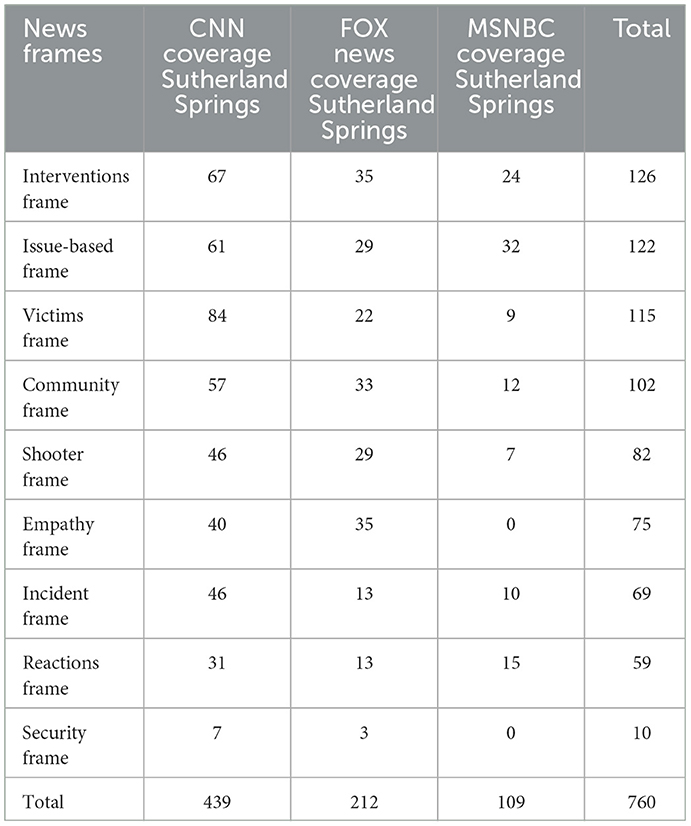
Table 1. Emerged frames in the CNN, Fox News, and MSNBC news coverage of the Sutherland Springs Texas mass shooting, and their unit code aggregate mean.
Interventions frame
The interventions frame encodes the news story around people's immediate actions as a response to the problem of mass shootings in the community, which often is represented as the community's effort to improve the situation by solving the problem that beset them. It is the most frequent of the nine emerged frames. CNN applied the intervention frame 67 times, FOX News 35 times, and MSNBC 24 times.
CNN's coverage of the interventions was framed mainly in the positive light of counter-responses and the investigative actions of law enforcement officials, FBI, and police toward making sense of the massacre that has come upon the community (References 10, 11, 14, 15, 17–19, 23–37,39–45, 47–50, 55, 56, 59, 60, 66–69). Counter-response stories are framed as strangers and unassuming heroes united in their readiness to promptly respond to save the community from the problem and their commitment to do it over again. “I would do it 100 times over” (References 1–3, 6, 7, 38, 46, 51). So, also, why better awareness of relationship violence is needed (Reference 20), a theme that was found only on CNN. Included was a frame around Texas Governor Abbot's declaration of state mourning (Reference 58) and Trump's tweets and remarks of support as a solution (References 6, 7, 11, 12, 57, 61), and dismissing of “extreme questions of vetting for gun ownership” (Reference 53).
FOX News approaches interventions through a political storyline of “Potus” and “Flotus” responses. Emphasizing the actions of the political class toward the shooting frames their actions as empathetic, actionable, prompt, and decisive and not the causes of the problem (References 1, 2, 21). It inserts the reactions of the Texas Governor, the leading Texas Senator, and the Texas Attorney General within the framing storyline that seeks more houses of the worship security plan and highlights the shooter's culpability (References 8–11, 16–18, 25, 32, 40). Moreover, it portrays the officials' responses as an investigating effort to discover the shooter's motive (References 13–15, 22–24, 26–30, 36, 37, 50, 51) and “encourage active shooter training” (Reference 43) as a response, emphasizing the value of safety and self-defense. When it reports the interventions of the two counter-responders, it does so in the broader context of numerous other legal gun owners. Also, it frames them as “heroes” who emerge from the affiliate NRA ideology. “The armed civilian who used his assault rifle to stop Sunday's mass murder of 26 Texas churchgoers has been hailed, rightly, as a hero, but Stephen Willeford is hardly unique. A number of armed American citizens have also used their firearms to stop or limit mass killings” (Reference 47–48).
MSNBC's frame follows a similar political line to Fox News, but is mainly limited or silent (framing by omission) on the “Potus” and “Fortus” frame composition, except the headlined Trump quote from an individual, “This isn't a guns (sic) situation” (Reference 2, 10–12). Thus, it frames the story along the lines of politicians' inaction to help the situation, the lack of responsibility of the Pentagon and the Air Force, and the failure of the political will to revisit the Second Amendment and gun reform (references 3, 12–26). Its pathos motif highlighting the lack of responsible response from political groups is direct as one gleans its frame package cues: “Can Texas be a catalyst for change in reform” (Reference 22) and “The mass shooting ‘play book': Will it change?” (Reference 24).
Issue-based frame
The issue-based frame encodes the news around the problem of policy, economics, beliefs, attitudes, values, or legal concerns in the political and cultural debates that requires change. It is the second most frequently occurring frame (n = 122). CNN coverage applied issue-based frames 61 times, FOX News 29 times, and MSNBC 32 times. The problem of gun debate (42.73%) is the dominant issue in all networks, but other issues emerged. Table 2 has the list of the emerged media frame packages and their percentage distribution within this theme.
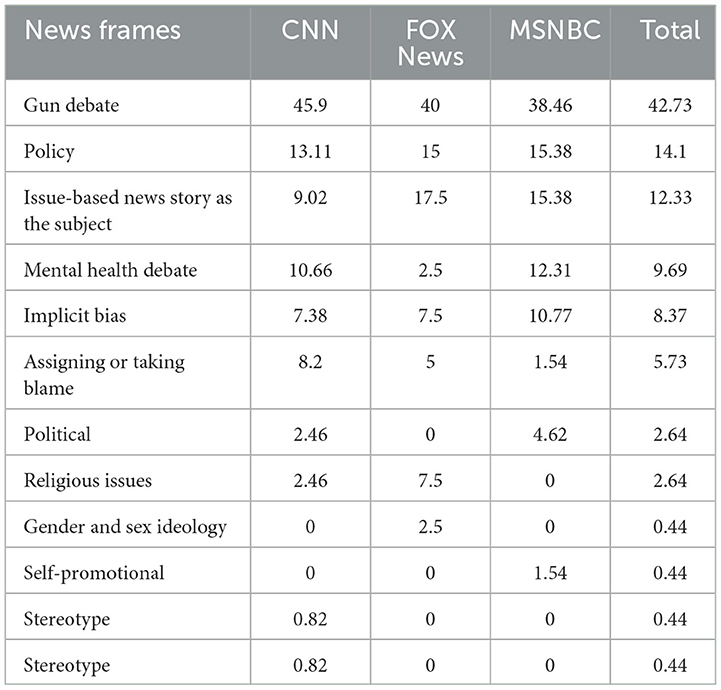
Table 2. Number of issues that emerged in the issue-based frame on CNN, Fox News, and MSNBC Sutherland Springs mass shooting coverage by percentage.
Concerning the dominant issues, CNN frames the story around three key problem definitions; gun policy (or law) failure (References 1–4, 9, 10, 11–15, 19–30, 38, 41, 42, 48), President Trump vs. Democrats political debates on guns (References, 29, 30, 31, 39, 40, 44, 45, 49, 52–77, 84), and the Texas rural communities “Why the church shooting hasn't changed rural Texans' minds about guns” or “more guns” (Reference 2, 5–8). It frames the community as overwhelmingly of the view that more guns are needed. It contrasts the story with a few instances focused on the victims' families. “Family's message to Trump: No more guns” (References 17, 18, 34, 35, 43, 78); or the subtle jab in favor of policy change rather than a prayer for fixing gun debates, “prayers will not fix this” (References 32, 33, 36; 82, 32, 33, 36). When mental health was presented, it is framed around Trump's rebuttal against gun control (References 102–105).
Fox News follows a different path, framing the stories around issues of personal culpability of the shooter for illegal gun access and policy failure (References 1, 2, 7, 8), the need for active shooter training (Reference 11), and mental health (References 9, 10). In addition, it encodes the stories within a broader context of the need for security, for churches to have armed security (References 12, 13, 14–16), and more training for active response against mass shooters (Reference 11). Likewise, it frames arguments against guns as “celebrities” calls against NRA (References 21–26, 27–29).
MSNBC, on the other hand, frames the story around gun policy failures (Reference 1) and Trump's refusal to accept that it is a gun situation (Reference 2, 16, 18, 20, 31, 50). The emphasis—Trump's choice, “Pentagon nominee accidentally tells the truth about gun policy” (References 18, 20, 23, 29)—heightens the narrative.
Victims frame
The victims frame focuses on the victims of the mass shooting, including their families, friends, and relationships. It aims to answer questions such as “Who were the victims of the attack?” and “How are they portrayed?” and in what ways are their painful experiences depicted as a broader experience of victims of mass shootings? It is the third most frequent frame. CNN's victim frame occurred 64 times, Fox News occurred 22 times, and MSNBC 9 times.
CNN provided extensive coverage of the death toll (References 1–3, 1–29, 31–34, 83–85), victims' profiles, families, and identifications (References 67–68, 70–73), “including an unborn child” (Reference 69–70) portraying them not as numbers but people. It makes them “heroes of Texas church shooting” (References 67–68), with 14 profile videos devoted to this theme. Victims were portrayed as members of the community, whose relationships are those like anyone, and a loss of unimaginable estimation. There was extensive coverage of those who knew them and what their loss meant to everyone. “We ate together, we laughed together, we cried together, and we worshiped together. Now most of our church family is gone…” (References 119–121). Their loss is framed as that of 4% of the entire population and a loss that included children and eight members of one family (References 124–128).
Fox News coverage frames the victims' stories within the “stories of heroism” (References 9–11). The victims—the 26 deaths and numerous wounded—are presented as family, “Texans respond to shooting: It impacts us all as a family” (References 12–17, 25–27), and whenever a profile is presented, emphasis is placed on its relation to the family (References 21–40). Also, the result shows the placing of survivors' or victims' stories side by side with the Texas heroism of the survivor (Reference 1, 2) or in counter-response by community members. “Here's what we know about the victims and the heroic attempt to stop the gunman” (Reference 6). The family-survivor-hero motif was apparent.
MSNBC's news frame on the victims focuses on the death toll and their demographics, “who were the victims of the Sutherland Springs Massacre” (References 1, 2, 5–8). Its salience of facts about causalities was a stronger motif. However, it inserts the story of a grandmother of multiple victims “My whole body's just numb” (References 12–14), the only instance of the emotive motif. Unlike in CNN and Fox News, where heroism was the emphasis, in MSNBC's case, victimhood was the motif.
Community frame
The community frame encodes stories framed around the community and the impact of the shooting on the community and the people's way of life. The problem definition is about how the people of the community are portrayed—their population and demographics, culture and experiences, the impact of the shooting on their way of life, and their responses to the shooting as a moral call to action. It is the fourth most frequently occurring frame. CNN applied community frame 56 times, FOX news 33 times, and MSNBC 12 times. Each of the three cable news networks framed their stories around the community in different, sometimes parallel, ways revealing different ideologies and narrative emphasis.
For CNN, most frame packages focus on the resilience of the rural, small community as a people and a faith community. “Undeterred, First Baptist Church will hold service” (References 33, 34, 37, 40–45; 20–27). Amplifying their casual and rural way of life, it depicts the faith community and its people as “often clad in T-shirts and jeans, have long been a stalwart of the community—helping feed the needy and clean up neighbors' property after storms” (References 33, 34, 37, 40–44; 70, 71). Members are portrayed as those who rally around each other to heal (References 1, 2, Additional References 1, 11) or respond as “heroes” actively engaged in the counter-response to the shooting to save the community (References 13, 16, 17, 48, 49, 57, 62–64, 67–69, 76; Additional Reference 2).
Fox News frames are mainly around the community as engaged, active (References 53, 54), and as a family (References 21–23) that responds to the shooting in solidarity to mourn the losses of their loved ones: “Mourners participate in a candlelight vigil” (References 1–4, 7–12). In addition, it frames the story around accounts of community members' participatory faith leadership (References 21–25), counter-responses, eye-witnesses, and survivors who are presented as “heroes” (References 5, 14–16, 44). Unlike on CNN where the counter-responders were presented as the heroes of the community, on Fox News, it was a whole group of counter-responses, eye-witnesses, survivors, and victims who were emphasized as heroes.
MSNBC's frames focus on Sutherland Springs, a closely “tight-knit community” (References 8, 9) where “everyone knows each other” (References 5–7, 14, 15), but a community that is “shaken” (Reference 6) and devastated by the shooting and seeking answers (Reference 1–3, 13–13).
Shooter frame
The shooter frame encodes the news story around the shooter as the central focus. It focuses on the shooter as the story's main subject and delves into questions about their motives and actions. It is the fifth most frequent frame. CNN applied the shooter frame 46 times, FOX News 29 times, and MSNBC 7 times.
For CNN, the shooter is a miserable villain who is violent and cruel to people and animals, a domestic abuser, rejected by the community, the family, and the church, and who has many “red flags” that could have been detected (References 1–15, 18, 19–26, 27–33, 69, 70). He is active on social media and is infatuated with guns and violence, posting “about his rifle and his affinity for mass shooting” (Reference 16) and has mental problems (References 27–33, 34, 49–56) and a troubled past (Reference 37–48). His motives are framed as a miserable, loser response to domestic issues (Reference 57).
Fox News frames the shooter in a slightly different way: “A disturbing past” and violence history (Reference 17, 34), and “severe mental challenges” (References 19, 20, 22, 23) who was “denied carry permit” (References 26, 38). The problem definition of the shooter was personal culpability and mental issues.
MSNBC frames the shooter as one who has a “disastrous history in the United States Air Force” (3) but whose motives were; “... we don't know why it happened, to the extent that these things can ever be known. However, we do know how it happened. It wasn't that this guy turned crazy on people. He turned a military-grade semiautomatic firearm on these people, in an enclosed space” (References 4, 5). Thus, the problem definition is about military-grade semiautomatic gun access and failed gun policy, of which the shooter's access is the cause of the massacre.
Empathy frame
The empathy frame encodes messages, kind words, or concrete actions that show empathy or kindness toward the community, victims, or the shooting incident. Also, it humanizes peoples' responses to the problem and reveals the value embedded in the collective response to a painful incident such as a mass shooting. It is the sixth most frequent frame and emphasizes one aspect or another of the incident and reveals salience by omission to a human response to a tragedy of this kind. CNN applied the empathy frame 40 times, FOX news 35 times, and MSNBC 0 times. Whereas CNN and Fox News portray some aspects of the story with empathetic depictions, MSNBC does not have any data that emphasizes an empathetic narrative.
CNN's empathy frame emphasizes the empathetic actions of a “Texas casket maker” who offers free coffins for all dead victims (Reference 1, 11, 12, 36) and the San Antonio, Texas, hospitals treating patients (Reference 2, 34, 35). Thus, CNN was about the people of the community who are portrayed as empathetic and present to each other in their pains. Coverage also focuses on the empathetic and motivating sermon of the pastor who is hurting from the losses of members of his family (References 3–8) and the community's collective healing and spiritual support (References 13–15, 22–33, 37–55).
Fox News' frames share much in common with CNN, using the Texas casket maker's empathetic gesture to the dead as an instance (References 1). However, most of the story focuses on the collective actions of the community in healing each other through empathetic condolences, reactions, participatory presence, and prayer services (References 1–8, 19–23). In addition, the “Full Military Veterans Day Salute” for the shooting victims is highlighted (References 8, 9), as well as reactions from celebrities, pastors, and public figures in solidarity with the victims and their community (References 10–14, 23–40).
Incident frame
The incident frame tells the story in a way concerned with the incident, the problem of the actual shooting event. It answers the question, what happened and why this particular incident? Every news report on mass shootings may seem to be about the incident. However, how the incident is reported makes a difference in audiences' view of the story and often reveals ideological biases. The incident frame is the seventh most frequently occurring news frame. CNN's incident frame occurred 46 times, FOX news 13 times, and MSNBC 10 times.
CNN frames the incident in a historical context as one of the “deadliest shootings in modern U.S. history” and the largest in Texas (References 1, 4, 6, 7, 8–20, 42, 44, 46, 49, 50). Within this historical context, it tells the story with careful distinctions about why it is not terrorism (References 40, 41) and proceeds with a picture of the scene, the sequence of events at the shooting, the “horrific sight” of the incident (References 21–31), and the “what we know” or “how it happened” chronology of events (References 36, 37, 47, 48, 51, 52). One notices that though the casualties of the shooting were mentioned, it was often framed in historical contexts of antecedents and the Texas community's way of life.
Fox News also frames the incident in a historical context (References 5, 10, 15, 17). However, it portrays the picture of history as one in which the “good guy with gun takes down mass shooter” (Reference 13) or its correlate as a historical incident for gun access (Reference 10) and one which should not be political (Reference 14). It then frames the graphic picture of the scene: “Church in Texas shooting massacre still has blood on ceiling, bullet holes in Bibles” (Reference 15), emphasizing the impact of the shooting on one of the things Texans cherish the most—their church and their Bible.
MSNBC frames the incident in a historical context but discusses it in light of ongoing political debates, elections, and the need for gun control (References 1, 2–4, 4–12). Coverage is limited to the chronology of the incident and the scene.
Reactions frame
The reactions frame centers the story around people's responses or statements to the incident rather than on the event itself. Unlike the “Interventions frame,” which focuses on the actions of non-victims or non-eyewitnesses, the “Reactions frame” focuses on verbal statements made by individuals or groups. By highlighting these reactions, the news media encourages the audience to consider the shooting in light of the comments made by individuals they deem noteworthy. Its problem definition is using the statements as a way of shaping audiences' perception of what happened or as a way for the audiences to think about what happened. The reactions frame is the eighth most frequent of the nine frames emerging in the cable news coverage of the mass shooting. CNN applied the reactions frame 31 times, FOX news 13 times, and MSNBC 15 times.
CNN focused mainly on the political class—the presidency (References 2, 3;−18, 21, 22, 23–25, 27), the vice president (Reference 4, 5, 22), some members of Congress (Reference 19, 22) and the Texas governor (Reference 1), a couple of journalists (Reference 20), and a few comments on victims' family and survivors (Reference 26). It portrays the political class as caring and outreaching to the community's concerns. Frequent references to “President Trump” seem to court Texas' seeming friendship with him.
Fox News' reactions frame is different from CNNs' because the focus is mainly on Vice President Pence's comments (References 4, 9, 11) and “Trump, politicians react” (References 1, 13). It includes Trump's family (Reference 2) and paints a picture of celebrities' reactions as a non-consensus interest group with diverse agenda. “Celebrities react to Texas church mass shooting” (Reference 12).
MSNBC's reactions frame packages focus on the reactions around President Trump. It portrays Trump as one with a mixed-message of denial about guns, condemnation of the act as “murderous” and “act of evil,” and identifying with the community “We will Never Ever Leave their side” (References 6, 10) while depicting the president as wittingly or unwittingly making matters worse. “Whether the president understands this or not, Donald Trump has taken steps to make matters worse regarding mental health and guns” (References 1, 5). VP Pence is framed as one who visits the sight and offers support (References 3, 4), and President Obama is one who “grieves” and “stands with” the Sutherland Springs' families and survivors (Reference 11).
Security frame
The security frame represents the news story around security and safety issues as a social problem that requires a response. This frame is the least frequent of the nine emerged frames. CNN applied the security frame seven times, Fox News has it three times, and MSNBC has zero times. CNN's use of a security frame focuses on security as a matter of “top priority for churches” that must be prepared (References 1–3, 5) and a general USA problem. “Finally, we have to accept that no place is safe, and everyone is now a suspect,” a culture of fear (Reference 6). Fox News' security frame focuses on prioritizing security as a community need, if not an act of necessity (Reference 1), championed by community faith leaders toward making sense of the massacre which is a problem that has come upon the community (Reference 3), and endorsed by the Sherriff who encourages “active shooter training” (Reference 2).
RQ2 asks overall, if there are any differences in the types of news frames used (and their frequency) by CNN, Fox News, and MSNBC when considering the news networks' combined coverage of the Sutherland Springs mass shooting across their official Twitter, YouTube, and website accounts. Tables 3.1–3.3 present the results. Additional one-way ANOVA tests for the differences in channel coverage (CNN, FOX News, and MSNBC) and digital platforms (Twitter, YouTube, and website) are provided in Appendices 1, 2.
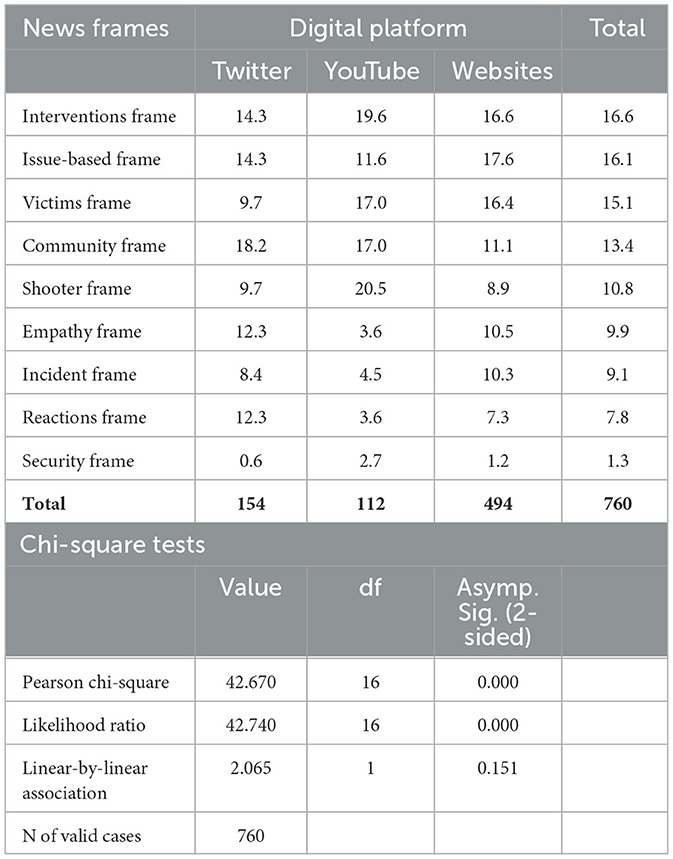
Table 3.1. Percentage of news frames reporting by digital platform for all news channels (CNN, Fox News, and MSNBC).
There are significant differences in the frame use between the three digital platforms. For instance, while overall, the interventions frame is the most frequently used across all platforms, it is the second most frequently used for websites. The community frame use tops on Twitter, shooter frame on YouTube, and issue-based frame on websites. Security frame is the lowest used in all platforms. Furthermore, the results from the chi-square tests indicate that there are statistically significant differences among the categories of platforms and news frames. The Pearson Chi-Square and Likelihood Ratio values are both significant at p < 0.001, suggesting that the observed differences in the distribution of news frames across the three digital platforms are not merely due to chance.
The chi-square test for testing the difference among categories of news frames shows that there are significant differences in the distribution of news frames. Issue-based, interventions, victims, and community frames were used more, while other frames such as empathy, incident, shooter, reactions, and security were used less.
Similarly, the chi-square test for testing the difference among categories of digital platforms reveals significant differences in the distribution. The observed frames used on Twitter and YouTube were lower, while the website was much higher. It shows that the news networks' websites may be utilizing a wider variety of news frames compared to Twitter and YouTube.
Furthermore, two distinct one-way ANOVA tests were conducted to examine the differences in channel coverage (CNN, FOX News, and MSNBC) and digital platforms (Twitter, YouTube, and website). The normality tests for each set of frames within Channel Coverage (CNN, Fox News, and MSNBC) demonstrated that they individually adhered to a normal distribution, as evidenced by p-values exceeding 0.05. The one-way ANOVA result showed a significant disparity among the frames [F(2, 24) = 12.58, p < 0.001]. Tukey pairwise comparisons indicated that CNN frame use in their coverage possessed a significantly higher mean (M = 43.22) in comparison to both Fox News coverage (M = 23.56) and MSNBC coverage (M = 12.11). Fox News and MSNBC coverages show no significant differences. Appendix 1 has tables and charts providing details of the analysis.
Regarding digital platforms (Twitter, YouTube, and website), the assumption of normality was not met for all frame groups. Hence, the non-parametric Kruskal–Wallis test was employed. The findings displayed a significant discrepancy among the group of frames [H(2) = 12.70, p = 0.002]. However, post hoc analyses were not conducted due to the exploratory nature of this study. Appendix 2 has tables and charts providing details of the analysis.
RQ3 seeks to find if there are statistically significant differences in CNN, Fox News, and MSNBC's use and frequency of the identified news frames in their coverage of the Sutherland Springs mass shooting on Twitter. CNN has a total of 60 Tweets, Fox News has a total of 30 Tweets, and MSNBC has a total of 16 Tweets. The results are presented in Tables 4.1–4.3.
Examining the percentage of news frames reporting by channels for tweets, notable differences between the three channels are observed. MSNBC has a higher frequency of issue-based frames, although the network's total frame counts are relatively very low, while Fox News has a significantly higher percentage of empathy frames compared to the other channels. Conversely, the community frame is the most used on CNN.
The results from the chi-square tests indicate that there are statistically significant differences among the categories of news channels and news frames. The Pearson Chi-Square and Likelihood Ratio values are both significant at p < 0.001, suggesting that the observed differences in the distribution of news frames across the three channels are not merely due to chance.
The chi-square test for testing the difference among categories of news channels shows that CNN has a much higher observed count of frame packages than the expected count, while Fox News and MSNBC have lower observed counts.
The chi-square test for testing the difference among categories of news frames reveals significant differences in the distribution of news frames. The issue-based, interventions, and victims frames make up about 46.75% of all frames used.
RQ4 seeks to determine if there are statistically significant differences in the CNN, Fox News, and MSNBC's use and frequency of use of the identified news frames in their coverage of the Sutherland Springs mass shooting on their YouTube. CNN has 9 YouTube posts. Fox News has a total of 92 and MSNBC has 2. The data obtained from the study are presented in Tables 5.1–5.3, with the main focus being on the percentage of news frames reporting by channels for tweets and chi-square tests.
Regarding the percentage of news frames reported by channels for YouTube, some notable variations can be observed. MSNBC's single news report solely focused on the shooter frame (100%). CNN's dominant use of the victims frame is observed. Fox News shows a diverse range of frames with the interventions frame being the most prominent.
The chi-square tests reveal no statistically significant differences among the categories of news channels and news frames based on Pearson Chi-Square and Likelihood Ratio values (p = 0.733 and 0.780, respectively). This suggests that the observed differences in the distribution of news frames across the three channels may be due to chance.
However, when examining the chi-square test for testing the difference among categories of news frames, there is a significant difference in the distribution of news frames (p < 0.001). Shooter and interventions frames have higher observed counts than expected, while frames such as incident, shooter, reactions, and security have lower observed counts. This indicates that certain frames are more frequently used compared to others in the coverage of the Sutherland Springs mass shooting on YouTube.
Similarly, the chi-square test for testing the difference among categories of news channels reveals significant differences in the distribution of news channels (p < 0.001). Fox News has a much higher observed count than expected, while CNN and MSNBC have lower observed counts. This suggests that Fox News may be utilizing a wider variety of news frames on YouTube compared to CNN and MSNBC.
RQ5 asks if there are statistically significant differences in the use and frequency of CNN, Fox News, and MSNBC news frames on their websites. CNN has a total of 67 news reports, Fox News has a total of 10, and MSNBC has 44. The observed frequencies are given in Tables 6.1–6.3.
The percentage of news frames reporting by channels for websites data indicates notable differences, with issue-based, interventions, and victims frames toping overall. For instance, MSNBC appears to have a higher frequency of issue-based and interventions frames, while Fox News has a significantly higher percentage of empathy frames compared to the other channels. Conversely, CNN used the victims frame the most.
The results from the chi-square tests indicate that there are statistically significant differences among the categories of news channels and news frames. The Pearson Chi-Square and Likelihood Ratio values are both significant at p < 0.001, suggesting that the observed differences in the distribution of news frames across the three channels are not merely due to chance.
The chi-square test for testing the difference among categories of news channels demonstrates that CNN has a much higher observed count usage of all frames than the expected count, while Fox News and MSNBC have lower observed counts.
Similarly, the chi-square test for testing the difference among categories of news frames reveals significant differences in the distribution of news frames.
Analytic discussion
This study provides a new contribution to frame scholarship by identifying nine frames, four of which are new in frame analysis of mass shooting news coverage. The four new frames include empathy, interventions, reactions, and security. The discovery of these new frames reinforces the argument that a grounded approach to frame analysis that examines each case as unique leads to richer discovery in the texts of the news coverage. It enriches scholarship and sheds light on new issues that are embedded in the news media coverage of mass shootings. Also, the results support research about the presence of the community frame (Muschert and Carr, 2006) and Goffman (1974) predominance of victims and individuals rather than the gun debate. They dispute those of Schildkraut and Muschert's (2014) frame analysis of Sandy Hook which identified the rise of gun ownership or debate frames as the dominant news frame in mass shootings news coverages. Moreover, the findings provide nuances in the US cable news framing of mass shooting on digital platforms of Twitter, YouTube, and websites.
The identified nine frames
Earlier research on mass shootings (Muschert and Carr, 2006) identified individual and community frames but presented them in a generic sense. These research findings are more descriptive by identifying different ways individuals are framed. They include individuals as victims (within the victims frame), members of the community (within the community frame), the interventions of individuals (interventions frame), and their reactions (reaction frame). Therefore, the result provides more data for an examination of how the stories of individuals are told in the coverage. Such data will be useful in the interdisciplinary study of how news media portray individuals in news frames, a subject anthropologists, sociologists, and cultural studies researchers might find relevant. Similarly, this research clarifies the community frame as well. While previous research did not show the prominence of the community frame, this study corroborates Dahmen et al. (2018) survey of journalists, which found that although actual news reports seem not to pay sufficient attention to frames around the community, community frame is the journalists' preferred choice for framing the news of the mass shooting to articulate community resilience as a moral value and shed light to solutions of the painful problem of mass shootings.
Moreover, the findings suggest a much more complex set of issues at play than a single-issue frame analysis approach may suggest and agree with Holody and Shaughnessy's (2022) claim that news frames of mass shootings are more complex than a single-issue debate. Other issues regarding this mass shooting news coverage make up about 51% of the rest of the issue-based frame, indicating a need for an encompassing approach that looks at each case as unique and nuanced (Mosqueda et al., 2021; Holody and Shaughnessy, 2022).
One of the most important contributions of this research is that its findings reveal other issue-based themes that previous research on mass shooting stories did not identify. The findings reveal that while guns were a major issue comprising 42.73% of a dozen issue-based frames that emerged, they only accounted for 4.67% of all main (nine) frames that emerged in the sampled news stories across the networks. The mental health issue has far less emphasis; it is 9.69% of all issue-based frames. In comparison to gun debate issues, it has about a fourth of the news frame occurrences. And in relation to the 9 total main frames that emerged in the reports, it is about 1.06%. Most important is the discovery of the way these two issues were framed as the pro-vs.-anti-gun/health issue propositions, and each cable network rehearsing their ideological bents, amid the reality of a horrible and painful incident of this kind.
The data appears to indicate lesser emphasis from US cable news outlets in reporting on mental health and gun policy. When mental health and gun debate combine for about 5.73% of all frames, it raises further questions about how cable news networks play an active role in fostering awareness of two issues that deserve critical attention in the current history of mass shootings in the United States. It might have implications in the shaping of public safety discussions and policy. A more comprehensive exploration into this topic may shed further light on what changes can be implemented to help reduce incidences involving firearms through improved dialogue around issues related to both gun control legislation and mental healthcare policies.
Although the shooting in this case study is a tragic incident that gained national attention and the shooter was previously diagnosed with a mental health issue and violent behavior, it should also be observed how the cable news networks' identified frames have a lesser emphasis on mental health issues as a real problem in its own right. By deemphasizing mental health issues to cater to their political ideological bents for gun control (in the case of MSNBC) or framing the story as about mental health rather than gun issue (Fox News), all of which are framing by omission, the sampled cable news media networks might be shifting the conversation away from a focused discussion on mental health. It reinforces the either-or (or the us against them) rhetoric that fuels divisive postures. Responsible reporting that does not frame the issue of mass shootings as divisive rhetoric is required for a meaningful discussion that could lead to a better policy to solve the problem.
Another finding of this research is that it reinforces the picture that cable news framing of mass shootings reflects the political views of the media source and the potential audience. For example, MSNBC did not have any content encoding empathy. D'Angelo (2017) and Entman (1993) agree that the omission of possible relevant topics frames the story in another way. On the other hand, Fox News has a high number of empathy frames. A vital insight is understanding that the Sutherland Springs community leans right, and the Fox News empathetic messaging also relates to the victims (Fox News right-leaning target audience) contrary to MSNBC (a left-leaning target audience). This raises the journalistic question if, in the case of mass shootings, news frames change based on the victims of the shooting and how they relate to the news media ideology. Moreover, if that is the case, it raises further questions about implicit bias in the news frames of mass shootings in the US cable news and journalistic responsibility in the age of divisive digital rhetoric. It takes us back to the perennial argument about media effect and critical cultural approaches to media studies—whether it is the media that shape our conversations, or the us that use media for what we desire of them, or simply that the media reinforce audiences' views of the world.
Additionally, variations in news framing across different digital platforms raise questions about the role of platform affordances and audience engagement in shaping news reporting practices. Irrespective of the cable news network, it appears that when it comes to news coverage of the three sampled digital platforms, framing changes as one group of frames is emphasized in one news network and not in another. This discovery needs further examination in subsequent research.
Nuances in the frames on websites, Twitter, and YouTube
News frames on Twitter provide sufficient results for an analytic discussion. If, as the Pew Research Center study found, the majority of U.S. adult Twitter users are younger and more likely to be Democrats than the general public, 80% of the tweets come from 10% of all Twitter account users (2020), and most Twitter engaged communities are more highly educated and have somewhat “different attitudes” than the USA average (Wojcik and Hughes, 2019), then the mediation role of the platform in the context of this study needs a closer examination. Considering the percentage of news frames reported by channels for Tweets and the chi-tests (Tables 4.1–4.3), the variations in the distribution of news frames among the channels are indicative of variations in the framing of the stories. Both CNN and Fox News exhibit similarities in their utilization of news frames, whereas MSNBC's coverage significantly diverges from the others. The p-values for the Pearson Chi-Square and Likelihood Ratio tests fall below 0.05 (p < 0.001), signifying significant differences in the employment of news frames across the channels.
These distinctions exist not only within the frames themselves but also among the news channels and the frames they choose to use. Although, overall, the residuals indicate that issue-based, interventions, victims, community, and empathy frames have higher observed frequencies than expected, there are subtle differences in the frame compositions within the networks. Conversely, incident, shooter, reactions, and security frames display lower observed frequencies than anticipated and the distribution of these lower identified frames are uneven as well. CNN presents a higher frequency of various news frames, including issue-based, interventions, victims, and community frames, in comparison to the expected values. Fox News, albeit with some differences, follows a pattern akin to CNN, though with lower frequencies. In contrast, MSNBC exhibits a significantly distinct distribution of news frames, characterized by lower frequencies across all categories. This suggests that CNN may be utilizing a wider variety of news frames compared to Fox News and MSNBC.
However, what does low representation (standardized residuals of −16.1) on security frames on Twitter mediation for all three cable networks suggest? Does it suggest a cultural disconnect between the educated class and the rural communities such as Sutherland Springs, whose concerns might differ from the typical Twitter consumer? Is it the digital platform shaping the conversation or the news media responding to the kind of content its target audiences seek? In other words, is it an indicator of Twitter users' shaping, or rather agenda chasing of the news (Katona et al., 2017), the frame of public discourse? These questions gain significant importance when the results show that the issue-based frame was a major factor in differentiating MSNBC Tweets from CNN and Fox News. Notably, 38.1% of all frames that MSNBC applied in their tweets were issue-based, a proportion significantly higher than that of the other two networks. The issue-based frame seems consistent with the average U.S. Twitter user, whose demographics are often concerned with debates around issues (Wojcik and Hughes, 2019). Moreover, one notices that MSNBC has more Tweet frames content (26) than YouTube (1). By exploring how the frames found on Twitter differ across three news networks, scholarship has a better understanding of how each cable network shapes public discourse of this kind on Twitter.
YouTube
YouTube's mediation is a story of other competing ideologies. The overall prominence of the shooter frame (residual, 10.6) is worth commenting on. The overemphasis on the shooter frame (20.5% of all frames found on YouTube) can result in a distorted public understanding of mass shootings, as it diverts attention away from other critical aspects such as the victims, community impact, policy debates, and preventive measures. This focus on the perpetrator might lead to an incomplete or biased perception of the broader context surrounding mass shootings.
The 2020 Pew Research findings show that YouTube is the second largest social media source of news for Americans; 55% of active users lean left, and 42% lean right. On the other hand, Shearer and Mitchell (2020) acknowledge that this is likely because the more significant population of social media users is relative to young age, most of whom tend to lean left. However, much digital content qualitative research recognizes YouTube's strategic position as a digital ecosystem for cultural and alternate conversations, or as Rebecca (2020) describes it, reactionary political discourse. Leung and Lee (2014) label this phenomenon—a counterpublic. The current digital affordances of the platform are the ability of content generators and creators to amplify their voices and form a community around their content's niche. YouTube's mediation that shows the predominance of frames on Fox News (96) more than CNN (15) and MSNBC (1) suggests the networks' preferences for the YouTube kind of community, a counter-public (Leung and Lee, 2014). Fox News' application of identified frames—community frame, interventions frame, issue-based frame, and shooter frame—contributed to the significant differences among the networks. It seems aligned with the Fox News narrative that tells the story of itself as a reaction against the mainstream media.
Websites
Findings from the sampled networks show that websites provide a reasonable space for appreciating the cable news mediation of news text. They are a good source for identifying each network's frame packages and, based on this research findings, are the most dominant digital platform where the cable news frames emerge. The issue-based, interventions, and victims frames have higher observed frame package counts, indicating that these frames are more frequently used compared to others such as the community, empathy, incident, shooter, reactions, and security frames. The analysis of standardized residuals for each frame reveals meaningful insights into the usage patterns of specific news frames.
Also, the frame use percentage across the websites of CNN, Fox News, and MSNBC provide additional information. In particular, the victims frame, empathy frame, and security frame display significant variations in their representation on these networks' websites. The victims frame is most emphasized on CNN's website (20.5% of its 341 frame packages). This finding suggests that CNN places a greater emphasis on covering the victims of the Sutherland Springs mass shooting, focusing on their stories, experiences, and the impact of the tragedy on their lives. Conversely, Fox News and MSNBC appear to dedicate less attention to the victims frame (6.1 and 8% of their coverages, respectively), which might indicate a different approach to covering such events or a focus on other aspects of the incident. Furthermore, the empathy frame is highly represented on Fox News Website (28.8%, n = 66) and not applied on MSNBC Website (0%). This pattern implies that Fox News may prioritize expressing the value of empathy and conveying the emotional aspects of the event, fostering a sense of connection to the affected individuals and communities in this specific case.
On the other hand, MSNBC seems to downplay the empathy frame, which could be indicative of a more detached, analytical approach to reporting on mass shootings when it occurs in a community the network judges as not aligned with their political ideology. Perhaps, it is in this singular case of empathy frame that the ideological differences are much more apparent, as a network that leans right seems to show more empathy to the coverage if the community leans right and the network that leans left seems to frame the news differently. More studies of a similar incident from other news sources would help validate or disprove this claim. Finally, the security frame is not applied on Fox News and MSNBC's Websites, suggesting that these networks' framing of the story most probably omits focused discussions on security measures, policies, and the potential prevention of future incidents. These findings may reflect an editorial choice, audience preference, or a broader trend in the network's approach to covering mass shootings.
Despite the analysis revealing significant disparities in audience engagement across Twitter, YouTube, and website platforms, the violation of normality assumptions between the frame packages in these digital platforms indicates the need for further investigation into the characteristics and factors contributing to these differences.
Conclusion and limitations
This study shows that ANTMA grounded device is an effective method for frame analysis. As was shown, the results supported previous research and developed new frames to frame analysis research. The study also showed the importance of examining frames used on three digital platforms, Twitter, YouTube, and the website. It raises questions about using particular frames and platforms for specific audiences (age, political preference, and educational level).
Implicit in this approach is a non-dogmatic assumption that news frames are dependent on the type of the news story, the digital platform, and the socio-cultural settings within which the news occurs. It also theorizes that frames change as situations change. Therefore, the current findings must be interpreted in the light of the specific type of shooting it covers—mass shooting in a house of worship, and the specific medium of publication—digital platforms. Only when a metanalysis of other kinds of mass shootings and platforms agree with this discovery, a generalized theory would be formulated regarding the emerged frame themes rather than preconceived frames. Nevertheless, there is a unique constant in this new framework. It is that frames must be approached as a community of frames rather than just a binary categorization, and that saturated forms of frames within an incident provide a reasonable category through which media coverage navigates, and each new network is different on where it sits on each frame category.
Similarly, the research is limited to a shooting incident and written text samples. More research using this method should be conducted on a wider range of mass shootings, encompassing both cable and broadcast television, as well as analyzing video content, to determine whether similar or distinct news frames emerge. Additional research on how frames may be geared to the audience's values should also be done. For example, does the coverage of mass shootings outside the United States reflect the same frames and frequency and deal with the same set of values? Additionally, is framing culturally based? As the world becomes more global, the ability to understand how stories are framed and their potential impact on diverse people and cultures becomes more critical. This approach provides a step toward that understanding.
Data availability statement
The datasets presented in this study can be found in online repositories. The names of the repository/repositories and accession number(s) can be found below: https://osf.io/4sm89/.
Author contributions
The author confirms being the sole contributor of this work and has approved it for publication.
Acknowledgments
Special thanks to Dr. Jacqueline J. Schmidt (Professor Emeritus of Communication at John Carroll University) for her critical reviews and suggestions that improved the article, and to Dr. Mary Beadle (Professor of Communication at John Carroll University) for reviewing the draft. Gratitude is also extended to Dr. Margaret Finucane and Dr. Brent Brossmann, the author's colleagues at John Carroll University, for their feedback. Additionally, the author appreciates Regina Tuma (MSN, GNP, M.Ed) for assistance in the coding process, as well as Veronique Nlandu and Aiden Keenan, members of the author's John Carroll University student research team, for their help with data collection. Special thanks to John Carroll University (JCU) and the Tim Russert Department of Communication (JCU) for providing grants to publish this article. Special acknowledgment goes to the editorial team and reviewers of the Frontiers in Communication Journal for their reviews and feedback that further strengthened this study.
Conflict of interest
The author declares that the research was conducted in the absence of any commercial or financial relationships that could be construed as a potential conflict of interest.
Publisher's note
All claims expressed in this article are solely those of the authors and do not necessarily represent those of their affiliated organizations, or those of the publisher, the editors and the reviewers. Any product that may be evaluated in this article, or claim that may be made by its manufacturer, is not guaranteed or endorsed by the publisher.
Supplementary material
The Supplementary Material for this article can be found online at: https://www.frontiersin.org/articles/10.3389/fcomm.2023.1174946/full#supplementary-material
References
Baran, S. J, and Davis, D. K. (2020). Mass Communication Theory. 8th ed. Oxford: Oxford University Press.
Borah, P. (2011). Seeking more information and conversations: influence of competitive frames and motivated processing. Commun. Res. 38, 303–325. doi: 10.1177/0093650210376190
Cacciatore, M. A., Scheufele, D. A., and Iyengar, S. (2016). The end of framing as we know it … and the future of media effects. Mass Commun. Soc. 19, 2–23. doi: 10.1080/15205436.2015.1068811
Dahmen, N. S., Abdenour, J., McIntyre, K., and Noga-Styron, K. E. (2018). Covering mass shootings: journalists' perceptions of coverage and factors influencing attitudes. J. Pract. 12, 456–476. doi: 10.1080/17512786.2017.1326832
Dan, V. (2015). Patientengerichtete Werbung für verschreibungspflichtige Medikamente (DTCA)-Überblick und Forschungslücken [Direct-to-consumer advertising for pharmaceutical products (DTCA)—A literature review and directions for future research]. In M. Schäfer, O. Quiring, C. Rossmann, M. Hastall, and E. Baumann (Eds.), Gesundheitskommunikation im ge-sellschaftlichen Wandel: Chancen und Herausforderungen. Baden-Baden: Nomos. p. 63–73.
Dan, V. (2018). A methodological approach for integrative framing analysis of television news. In: D'Angelo, P., editor. Doing News Framing Analysis II: Empirical and Theoretical Perspectives. New York, NY: Routledge. p. 191–220.
D'Angelo, P. (2017). Framing: media frames. In: Roessler, P., Hoffner, C. A., and van Zoonen, L., editors. The International Encyclopedia of Media Effects. Hoboken, NJ: Wiley. p. 1–10.
D'Angelo, P. (2018). Doing News Framing Analysis II: Empirical and Theoretical Perspectives. Abingdon-on-Thames: Routledge.
D'Angelo, P., Lule, J., Neuman, W. R., Rodriguez, L., Dimitrova, D. V., and Carragee, K. M. (2019). Beyond framing: a forum for framing researchers. J. Mass Commun. Q. 96, 12–30. doi: 10.1177/1077699018825004
Data Reportal. (2022, January 26). Digital 2022: Global overview report. Data Reportal. Available online at: https://datareportal.com/reports/digital-2022-global-overview-report
De Vreese, C. H. (2005). The spiral of cynicism reconsidered. Eur. J. Commun. 20, 283–301. doi: 10.1177/0267323105055259
De Vreese, C. H. (2010). Framing the economy: effects of journalistic news frames. In: D'Angelo, P., and Kuypers, J. A., editors. Doing News Framing Analysis: Empirical and Theoretical Perspectives. New York, NY: Routledge. p. 203–230.
Entman, R. M. (1993). Framing: toward clarification of a fractured paradigm. J. Commun. 43, 51–58. doi: 10.1111/j.1460-2466.1993.tb01304.x
Entman, R. M., Matthes, J., and Pellicano, L. (2009). Nature, Sources, and Effects of News Framing: The Handbook of Journalistic Studies. New York, NY: Routledge.
Gamson, W. A., and Modigliani, A. (1989). Media discourse and public opinion on nuclear power: a constructionist approach. Am. J. Soc. 95, 1–37. doi: 10.1086/229213
Gitlin, T. (1980). The whole World is Watching: Mass Media and the Making and Unmaking of the New Left. Berkeley, CA: University of California Press.
Goffman, E. (1974). Frame Analysis: an Essay on the Organization of Experience. New York, NY: Harper and Row.
Graber, D. A. (1987). Television news without pictures? Crit. Stud. Mass Commun. 4, 74–78. doi: 10.1080/15295038709360115
Holody, K. J., and Daniel, E. S. (2017). Attributes and frames of the Aurora shootings: national and local news coverage differences. J. Pract. 11, 80–100. doi: 10.1080/17512786.2015.1121786
Holody, K. J., and Shaughnessy, B. (2022). #NEVERAGAIN: framing in community and national news coverage of the Parkland mass shootings. J. Pract. 14, 637–659. doi: 10.1080/17512786.2020.1816857
Iyengar, S. (1996). Framing responsibility for political issues. Ann. Am. Acad. Pol. Soc. Sci. 546, 59–70. doi: 10.1177/0002716296546001006
Jurkowitz, M., and Gottfried, J. (2022). Twitter is the Go-to Social Media Site for U.S. Journalists, but Not for the Public. Washington, DC: Pew Research Center. Available online at: https://www.pewresearch.org/fact-tank/2022/06/27/twitter-is-the-go-to-social-media-site-for-u-s-journalists-but-not-for-the-public/
Kahneman, D., and Tversky, A. (1984). Choices, values, and frames. Am. Psychol. 39, 341. doi: 10.1037/0003-066X.39.4.341
Katona, Z., Knee, J. A., and Sarvary, M. (2017). Agenda chasing and contests among news providers. Rand J. Econ. 48, 783–809. doi: 10.1111/1756-2171.12191
Kelly, R. (2012). Active Shooter Report: Recommendations and Analysis for Risk Mitigation. New York, NY: New York City Police Department.
Kleck, G. (2009). Mass shootings in schools: the worst possible case for gun control. Am. Behav. Sci. 52, 1447–1464. doi: 10.1177/0002764209332557
Krouse, W. J., and Richardson, D. J. (2015). Mass Murder With Firearms: Incidents and Victims, 1999 – 2013. Washington, DC: Congressional Research Service.
Lankford, A. (2015). Mass shooters in the USA, 1966-2010: differences between attackers who live and die. Just. Q. 32, 360–379. doi: 10.1080/07418825.2013.806675
Lankford, A. (2016a). Fame-seeking rampage shooters: initial findings and empirical predictions. Aggress. Violent Behav. 27, 122–129. doi: 10.1016/j.avb.2016.02.002
Lankford, A. (2016b). Public mass shooters and firearms: a cross-national study of 171 countries. Violence Vict. 31, 187–199. doi: 10.1891/0886-6708.VV-D-15-00093
Lankford, A., and Tomek, S. (2018). Mass killings in the United States from 2006 to 2013: social contagion or random clusters? Suic. Life-Threat. Behav. 48, 459–467. doi: 10.1111/sltb.12366
Leung, D. K., and Lee, F. L. (2014). Cultivating an active online counterpublic: examining usage and political impact of Internet alternative media. Int. J. Press/Pol. 19, 340–359. doi: 10.1177/1940161214530787
Lott, J. R., and Moody, C. E. (2019). Is the United States an outlier in public mass shootings? A comment on Adam Lankford. Econ. J. Watch 16, 37–68. Available online at: https://econjwatch.org/articles/is-the-united-states-an-outlier-in-public-mass-shootings-a-comment-on-adam-lankford
Luca, M., Malhotra, D. K., and Poliquin, C. (2016). The Impact of Mass Shootings on Gun Policy. Cambridge, MA: Harvard Business School, NOM Unit Working Paper No. 16-126.
McGinty, E. E., Webster, D. W., and Barry, C. L. (2013). Effects of news media messages about mass shootings on attitudes toward persons with serious mental illness and public support for gun control policies. Am. J. Psychiatry 170, 494–501. doi: 10.1176/appi.ajp.2013.13010014
McGinty, E. E., Webster, D. W., Jarlenski, M., and Barry, C. L. (2014). News media framing of serious mental illness and gun violence in the United States, 1997–2012. Am. J. Public Health 104, 406–413. doi: 10.2105/AJPH.2013.301557
Mosqueda, C. M., Heath, M. A., Cutrer-Párraga, E. A., Ridge, R. D., and Miller, E. (2021). Analysis of 48 hours of television news coverage following the Columbine High School shooting. School Psychol. Rev. 52, 1–15. doi: 10.1080/2372966X.2020.1870410
Muschert, G. W., and Carr, D. (2006). Media salience and frame changing across events: coverage of nine school shootings, 1997–2001. J. Mass Commun. Q. 83, 747–766. doi: 10.1177/107769900608300402
Nelson, T. E., Clawson, R. A., and Oxley, Z. M. (1997). Media framing of a civil liberties conflict and its effect on tolerance. Am. Polit. Sci. Rev. 91, 567. doi: 10.2307/2952075
Newman, R., Fletcher, R., Schulz, A., And,i, S., Robertson, C. T., and Nielsen, R. K. (2021). Reuters Institute Digital News Report 2021. 10th ed. Oxford: Reuters Institute for the Study of Journalism.
Peck, R. (2022). Comparing populist media: from Fox News to the Young Turks, from cable to YouTube, from right to left. Television New Media. doi: 10.1177/15274764221114349
Peterson, J., and Densley, J. (2022). The Violence Project Database of Mass Shootings in the United States (Version 5). Available online at: https://www.theviolenceproject.org.
Press Gazette. (2022, October 14). Top 50 news sites in the US in September: BBC and Mail Online among top three fastest-growing. Press Gazette. Available online at: https://pressgazette.co.uk/publishers/most-popular-websites-news-us-monthly-2/
Rebecca, L. (2020). This is what the news won't show you: YouTube creators and the reactionary politics of micro-celebrity. Television New Media 21, 201–217 doi: 10.1177/1527476419879919
Schildkraut, J., and Muschert, G. W. (2014). Media salience and the framing of mass murder in schools: a comparison of the Columbine and Sandy Hook massacres. Homicide Stud. 18, 23–43. doi: 10.1177/1088767913511458
Semetko, H. A., and Valkenburg, P. M. (2000). Framing European politics: a content analysis of press and television news. J. Commun. 50, 93–109. doi: 10.1111/j.1460-2466.2000.tb02843.x
Shearer, E., and Mitchell, A. (2020). News Use Across Social Media Platforms in 2020. Wasington, DC: Pew Research Center.
Silva, J. R., and Capellan, J. A. (2019). A comparative analysis of media coverage of mass public shootings: examining rampage, disgruntled employee, school, and lone-wolf terrorist shootings in the United States. Crim. Justice Policy Rev. 30 1312–1341 doi: 10.1177/0887403418786556
Silverstone, R. (2002). Complicity and collusion in the mediation of everyday life. N. Lit. His. 33. 745–764. doi: 10.1353/nlh.2002.0045
Tuchman, G. (1978). Making News: A Study in the Construction of Reality. Washington, DC: Free Press.
Van Gorp, B. (2007). The constructionist approach to framing: bringing culture back in. J. Commun. 57, 60–78. doi: 10.1111/j.1460-2466.2006.00329_5.x
Van Gorp, B. (2010). Strategies to take subjectivity out of framing analysis. In: D'Angelo, P., and Kuypers, J., editors. Doing News Framing Analysis: Empirical and Theoretical Perspectives. New York, NY: Routledge. p. 84–109.
Walter, D., and Ophir, Y. (2019). News frame analysis: an inductive mixed-method computational approach. Commun. Methods Measures. 13, 248–266. doi: 10.1080/19312458.2019.1639145
We Are Social. (2022, January 6). Digital 2022: another year of bumper growth. We Are Social. Available online at: https://wearesocial.com/us/blog/2022/01/digital-2022-another-year-of-bumper-growth-2/
Keywords: frame analysis, frame theory, cable news, digital platforms, mass shooting, grounded approach
Citation: Emelu MN (2023) The U.S. cable televisions' framing of mass shooting: a grounded discovery of competing narratives. Front. Commun. 8:1174946. doi: 10.3389/fcomm.2023.1174946
Received: 27 February 2023; Accepted: 30 June 2023;
Published: 25 July 2023.
Edited by:
Douglas Ashwell, Massey University Business School, New ZealandReviewed by:
Pytrik Schafraad, University of Amsterdam, NetherlandsJustin Reedy, University of Oklahoma, United States
Copyright © 2023 Emelu. This is an open-access article distributed under the terms of the Creative Commons Attribution License (CC BY). The use, distribution or reproduction in other forums is permitted, provided the original author(s) and the copyright owner(s) are credited and that the original publication in this journal is cited, in accordance with accepted academic practice. No use, distribution or reproduction is permitted which does not comply with these terms.
*Correspondence: Maurice N. Emelu, bWVtZWx1QGpjdS5lZHU=
†ORCID: Maurice N. Emelu orcid.org/0000-0002-6688-6620
 Maurice N. Emelu
Maurice N. Emelu